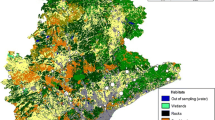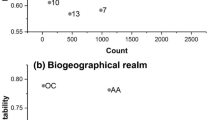Abstract
Most studies focused on understanding habitat invasibility use the current levels of invasion as a direct proxy of habitat invasibility. This has shown to be biased by the influence of propagule pressure and climate. We suggest that plant growth forms need to be considered as an extra factor, as habitat preferences might not be equal for all potential invaders. We test the influence of propagule pressure, climate and habitat characteristics on the current level of invasion and habitat invasibility, specifically addressing whether an analysis focused on growth forms evidence different patterns than the total pool of alien species. We used 499 floristic vegetation plots located in Córdoba Mountains. We used proportional alien richness of the total pool and for each growth form as response variables. We identified models that best explained current levels of invasion. We used the residuals of the models with propagule pressure and climate as the response variable. Then, we performed linear models to test the relationship between habitat characteristics and the residuals of the models. We found different drivers of current alien distribution patterns for the total pool and each growth form. Habitat invasibility was not equal when quantified for the total pool or growth forms. Shrublands and outcrops were recorded as less susceptible to woody invasion, while grasslands and native woodlands were resistant to the invasion of grasses and none habitat type was resistant to the invasion of forbs. We highlight that the current level of invasion and habitat invasibility are highly growth form dependent.


Similar content being viewed by others
References
Alexander JM, Naylor B, Poll M, Edwards PJ, Dietz H (2009) Plant invasions along mountain roads: the altitudinal amplitude of alien Asteraceae forbs in their native and introduced ranges. Ecography 32:334–344. doi:10.1111/j.1600-0587.2008.05605.x
Alexander JM, Kueffer C, Daehler CC, Edwards PJ, Pauchard A, Seipel T, MIREN Consortium (2011) Assembly of nonnative floras along elevational gradients explained by directional ecological filtering. Proc Natl Acad Sci USA 108(2):656–661. doi:10.1073/pnas.1013136108
Blackburn TM, Essl F, Evans T, Hulme PE, Jeschke JM, Kühn I et al (2014) A unified classification of alien species based on the magnitude of their environmental impacts. PLoS Biol 12(5):e1001850
Burnham KP, Anderson DR (2002) Model selection and multimodel inference. Springer, New York
Catford JA, Jansson R, Nilsson C (2009) Reducing redundancy in invasion ecology by integrating hypotheses into a single theoretical framework. Div Distrib 15:22–40. doi:10.1111/j.1472-4642.2008.00521.x
Catford JA, Vesk PA, White MD, Wintle BA (2011) Hotspots of plant invasion predicted by propagule pressure and ecosystem characteristics. Div Distrib 17(6):1099–1110. doi:10.1111/j.1472-4642.2011.00794.x
Cavieres LA, Badano EI, Sierra-Almeida A, Gómez-González S, Molina-Montenegro MA (2006) Positive interactions between alpine plant species and the nurse cushion plant Laretia acaulis do not increase with elevation in the Andes of central Chile. New Phytol 169:59–69
Charles H, Dukes JS (2007) Impacts of invasive species on ecosystem services. In: Nentwig W (ed) Biological invasions. Springer, Berlin, pp 217–237
Chytrý M, Jarosik V, Pysek P, Hajek O, Knollová I, Tichý L, Danihelka J (2008) Separating habitat invasibility by alien plants from the actual level of invasion. Ecology 89(6):1541–1553
Cingolani AM, Renison D, Tecco PA, Gurvich DE, Cabido M (2008) Predicting cover types in a mountain range with long evolutionary grazing history: a GIS approach. J Biogeogr 35(3):538–551. doi:10.1111/j.1365-2699.2007.01807.x
Cingolani AM, Vaieretti MV, Gurvich DE, Giorgis MA, Cabido M (2010) Predicting alpha, beta and gamma plant diversity from physiognomic and physical indicators as a tool for ecosystem monitoring. Biol Conserv 143:2570–2577. doi:10.1016/j.biocon.2010.06.026
Crawley MJ (1987) What makes a community invasible? In: Gray SJ, Crawley MJ, Edwards PJ (eds) Colonization, succession, and stability. Blackwell Scientific, Oxford, pp 429–453
Cronk QCB, Fuller JL (1995) Plant invaders, the threat to natural ecosystems, 1st edn. Chapman and Hall, London
Davis MA, Thompson K, Grime P (2005) Invasibility: the local mechanism driving community assembly and species diversity. Ecography 28(5):696–704. doi:10.1111/j.2005.0906-7590.04205.x
De Fina AL (1992) Aptitud agroclimática de la República Argentina. Academia Nacional de Agronomía y Veterinaria, Buenos Aires
Díaz S, Cabido M (1997) Plant functional types and ecosystem function in relation to global change. J Veg Sci 8(4):463–474
Dietz H, Edwards PJ (2006) Recognition that causal processes change during plant invasion helps explain conflicts in evidence. Ecology 87:1359–1367. doi:10.1890/0012-9658(2006)87[1359:RTCPCD]2.0.CO;2
Eschtruth AK, Battles JJ (2011) The importance of quantifying propagule pressure to understand invasion: an examination of riparian forest invasibility. Ecology 92(6):1314–1322. doi:10.1890/10-0857.1
Fazey I, Fischer J, Lindenmayer DB (2005) What do conservation biologists publish? Biol Conserv 124(1):63–73. doi:10.1016/j.biocon.2005.01.013
Fridley JD, Stachowicz Naem S et al (2007) The invasion paradox: reconciling pattern and process in species invasions. Ecology 88:3–7
Furey C, Tecco PA, Perez-Harguindeguy N, Giorgis MA, Grossi M (2014) The importance of native and exotic plant identity and dominance on decomposition patterns in mountain woodlands of central Argentina. Acta Oecol 54:13–20. doi:10.1016/j.actao.2012.12.005
Gavier-Pizarro GI, Kuemmerle T, Hoyos LE, Stewart SI, Huebner CD, Keuler NS, Radeloff VC (2012) Monitoring the invasion of an exotic tree (Ligustrum lucidum) from 1983 to 2006 with Landsat TM/ETM+ satellite data and Support Vector Machines in Córdoba, Argentina. Rem Sens Environ 122:134–145. doi:10.1016/j.rse.2011.09.023
Giorgis MA, Cingolani AM, Teich I, Renison R (2010) Do Polylepis australis trees tolerate herbivory? Seasonal patterns of biomass production and its consumption by livestock. Plant Ecol 207:307–319. doi:10.1007/s11258-009-9674-4
Giorgis MA, Tecco PA, Cingolani AM, Renison D, Marcora P, Paiaro V (2011a) Factors associated with woody alien species distribution in a newly invaded mountain system of central Argentina. Biol Invasions 13(6):1423–1434. doi:10.1007/s10530-010-9900-y
Giorgis MA, Cingolani AM, Chiarini F, Chiapella J, Barboza G, Ariza Espinar L, Morero R, Gurvich DE, Tecco PA, Subils R, Cabido M (2011b) Composición florística del Bosque Chaqueño Serrano de la provincia de Córdoba. Argentina. Kurtziana 36(1):9–43
Giorgis MA, Cabido M, Cingolani AM (2011c) Caracterización florística y estructural del Bosque Chaqueño Serrano. Editado por Editorial Académica Española (EAE). ISBN 978-3-8443-4123-2. Berlín, Alemania
Giorgis MA, Cingolani AM, Cabido M (2013) El efecto del fuego y las características topográficas sobre la vegetación y las propiedades del suelo en la zona de transición entre bosques y pastizales de las sierras de Córdoba, Argentina. Bol Soc Arg Bot 48(3–4):493–513
Holle BV, Simberloff D (2005) Ecological resistance to biological invasion overwhelmed by propagule pressure. Ecology 86(12):3212–3218. doi:10.1890/05-0427
Hulme PE (2009) Relative roles of life-form, land use and climate in recent dynamics of alien plant distributions in the British Isles. Weed Res 49(1):19–28. doi:10.1111/j.1365-3180.2008.00658.x
INDEC (2012) Censo nacional de población, hogares y viviendas 2010: censo del Bicentenario: resultados definitivos, Serie B No. 2. Buenos Aires, Argentina
Körner C (2007) The use of “altitude” in ecological research. Trends Ecol Evol 22(11):569–574
Kumschick S, Gaertner M, Vilà M, Essl F, Jeschke JM, Pyšek P et al (2015) Ecological impacts of alien species: quantification, scope, caveats, and recommendations. Bioscience 65(1):55–63. doi:10.1093/biosci/biu193
Lavorel S, Díaz S, Cornelissen JHC, Garnier E, Harrison SP, McIntyre S, Pausa JG, Perez-Harguindeguy N, Roumet C, Urcelay C (2007) Plant functional types: are we getting any closer to the Holy Grail? In: Canadell JG, Pataki DE, Pitelka LF (eds) Terrestrial ecosystems in a changing world. Springer, Heidelberg, pp 149–164
Lockwood JL, Cassey P, Blackburn T (2005) The role of propagule pressure in explaining species invasions. Trends Ecol Evol 20(5):223–228. doi:10.1016/j.tree.2005.02.004
Lonsdale WM (1999) Global patterns of plant invasions and the concept of invasibility. Ecology 80(5):1522–1536. doi:10.1890/0012-9658(1999)080[1522:GPOPIA]2.0.CO;2
Mack RN, Simberloff D, Londsdale WM, Evans H, Clout M, Bazzaz FA (2000) Biotic invasions: causes, epidemiology, global consequences, and control. Ecol Appl 103:689–710. doi:10.1890/1051-0761(2000)010[0689:BICEGC]2.0.CO;2
Marcora P, Hensen I, Renison D, Seltmann P, Wesche K (2008) The performance of Polylepis australis trees along their entire altitudinal range: implications of climate change for their conservation. Div Distrib 14(4):630–636. doi:10.1111/j.1472-4642.2007.00455.x
Marini L, Battisti A, Bona E, Federici G, Martini F, Pautasso M, Hulme PE (2012) Alien and native plant life-forms respond differently to human and climate pressures. Glob Ecol Biogeogr 21(5):534–544. doi:10.1111/j.1466-8238.2011.00702.x
Pauchard A, Kueffer C, Dietz H, Daehler CC, Alexander J, Edwards PJ et al (2009) Ain’t no mountain high enough: plant invasions reaching new elevations. Front Ecol Environ 7(9):479–486. doi:10.1890/080072
Pimentel D, Zuniga R, Morrison D (2005) Update on the environmental and economic costs associated with alien invasive species in the United States. Ecol Eco 52:273–288
Pivello VR, Carvalho VMC, Lopes PF, Peccinini AA, Rosso S (1999) Abundance and distribution of native and alien grasses in a ‘Cerrado’ (Brazilian savanna) biological reserve. Biotropica 31:71–82
Pyšek P, Křivánek M, Jarošík V (2009) Planting intensity, residence time, and species traits determine invasion success of alien woody species. Ecology 90(10):2734–2744. doi:10.1890/08-0857.1
R Development Core Team (2014) R: a language and environment for statistical computing. R Foundation for Statistical Computing, Vienna, Austria. http://www.R-project.org/
Rejmánek M, Richardson DM, Pyšek P (2013) Plant invasions and invasibility of plant communities. In: van der Maarel E, Franklin J (eds) Vegetation Ecology, 2nd edn. Wiley-Blackwell, Oxford, pp 387–424
Stohlgren TJ, Binkley D, Chong GW, Kalkhan MA, Schell LD, Bull KA et al (1999) Exotic plant species invade hot spots of native plant diversity. Ecol Monogr 69(1):25–46. doi:10.1890/0012-9615(1999)069[0025:EPSIHS]2.0.CO;2
Tecco PA, Díaz S, Cabido M, Urcelay C (2010) Functional traits of alien plants across contrasting climatic and land-use regimes: do aliens join the locals or try harder than them? J Ecol 98(1):17–27. doi:10.1111/j.1365-2745.2009.01592.x
Tecco PA, Pais-Bosch AI, Funes G, Marcora P, Zeballos SR, Cabido M, Urcelay C (2016) Mountain invasions on the way: are there climatic constraints for the expansion of alien woody species along an elevation gradient in Argentina? J Plant Ecol. doi: 10.1093/jpe/rtv064
Torres RC, Giorgis MA, Trillo C, Volkmann L, Demaio P, Heredia J, Renison D (2014) Overwhelming post-fire recovery by resprouting in the Chaco Serrano forest of Central Argentina. Austral Ecol 39:346–354. doi:10.1111/aec.12084
van Kleunen M, Dawson W, Essl F, Pergl J, Winter M et al (2015) Global exchange and accumulation of non-native plants. Nature 525:100–103. doi:10.1038/nature14910
Williams DG, Baruch Z (2000) African grass invasion in the Americas: ecosystem consequences and the role of ecophysiology. Biol Invasions 2:123–140. doi:10.1023/A:1010040524588
Wilson JR, Richardson DM, Rouget M, Procheş Ş, Amis MA, Henderson L, Thuiller W (2007) Residence time and potential range: crucial considerations in modelling plant invasions. Div Distrib 13(1):11–22. doi:10.1111/j.1366-9516.2006.00302.x
Zak MR, Cabido M (2002) Spatial patterns of the Chaco vegetation of central Argentina: integration of remote sensing and phytosociology. Appl Veg Sci 5(2):213–226. doi:10.1111/j.1654-109X.2002.tb00551.x
Acknowledgments
This study was conducted with the support of the Inter-American Institute for Global Change Research (IAI) CRNII-2005, SECYT and CONICET. We are thankful to N. Pérez-Harguindeguy, D. Gurvich, S. Zeballos, J. Astegiano, P. Venier, A. Pais, M. Bonino, L. Enrico, B. Garro, I. Lezcano, J. Alinari, V. Saur Palmieri and J.I. Whitworth-Hulse for their help in the data collection.
We also thank the associate editor and two anonymous reviewers, who made important suggestions that greatly improved the manuscript. M.G., A.C., P.T. and M.C. are researchers from CONICET.
Author information
Authors and Affiliations
Corresponding author
Electronic supplementary material
Below is the link to the electronic supplementary material.
Rights and permissions
About this article
Cite this article
Giorgis, M.A., Cingolani, A.M., Tecco, P.A. et al. Testing alien plant distribution and habitat invasibility in mountain ecosystems: growth form matters. Biol Invasions 18, 2017–2028 (2016). https://doi.org/10.1007/s10530-016-1148-8
Received:
Accepted:
Published:
Issue Date:
DOI: https://doi.org/10.1007/s10530-016-1148-8




